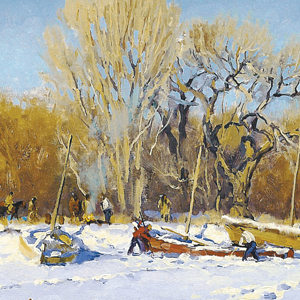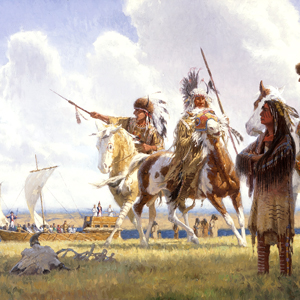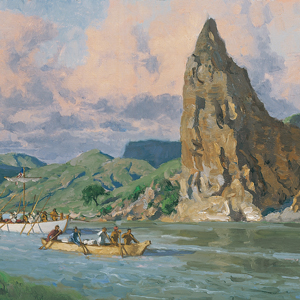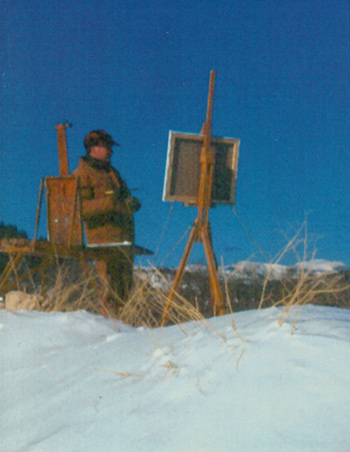Of his work, the artist Charles Fritz explains:
Historical accuracy is paramount, but there is another obvious component: the art itself . . . . In 100 Paintings Illustrating the Journals of Lewis and Clark, I sought to communicate the storyline accurately. I also wanted the paintings to be well designed, luminous, and painted with the brushwork and enthusiasm of an artist who is working from life—outside, in the presence of the actual scene.
—Complete Collection: 100 Paintings Illustrating the Journals of Lewis and Clark
Featured Works
December 31, 1804
Popular blacksmiths


At Fort Mandan below the Knife River Villages, the wind makes hills of snow and sand. The blacksmiths continue to trade their iron work for corn, and three men look for a suitable place to make canoes.
July 16, 1806
Off to the Marias


Lewis heads to the Marias River while Gass prepares wagon trucks above the Great Falls. Clark moves down the Yellowstone River by horse and Ordway paddles through the Gates of the Mountains.
August 24, 1805
Leaving Fortunate Camp


Lewis barters for three horses and a mule, Charbonneau buys Sacagawea a horse, and they and several Shoshone women head towards Lemhi Pass. On the Salmon River, Clark considers their options.
November 7, 1805
Ocean in view?


The expedition paddles around Columbia River islands and stops at two Wahkiakum villages. They reach a landmark presently named Pillar Rock where Clark mistakenly exclaims ‘Ocean in view! O! the joy’.
August 1, 1806
Waiting for buffalo


On the Yellowstone, Clark waits for a large herd of buffalo to cross. On the Missouri, Lewis passes the Musselshell River while Pryor’s group tries to catch up to Clark. Everybody is slowed by the weather.
October 24, 1805
Running the Short Narrows


The dugout canoes are safely run down the Short Narrows of the Columbia astonishing the local onlookers. Below the narrows, the expedition encounters their first Chinookan-speaking People.
October 25, 1805
A "bad whorl & Suck"


The expedition’s most valuable cargo is carried around the Long Narrows of the Columbia, and then the best paddlers run the canoes. At present The Dalles, Oregon, Fort Rock Camp is established.
April 5, 1805
Loading the small boats


The men load the red and white pirogues and six new dugout canoes. Sgt. Patrick Gass recalls the Indian sexual practices experienced during his stay at Fort Mandan amongst the Knife River Villages.
December 23, 1805
Clatstop traders


At Fort Clatsop, work on the cabins continues, and the captains move into their unfinished quarters. Clatsop traders sell food, mats, bags, and a panther hide for fishhooks, an old file, and spoiled salmon.
January 22, 1805
Boats gripped in ice


At Fort Mandan below the Knife River Villages, an unsuccessful attempt is made to cut the Missouri River ice from around the boats. They find two layers of ice nearly four feet thick.
March 4, 1806
Sumptuous living


At Fort Clatsop near Astoria, Oregon, the captains “live sumptuously” on eulachon and sturgeon. Continuing his March treatise on birds, Lewis focuses on western meadowlarks and jays.
June 1, 1804
Mouth of the Osage


After a hard day, the expedition stops at the mouth of Osage River where the captains make celestial observations late into the night. Lewis also collects a specimen of wild ginger, Asarum canadense.
April 13, 1805
The white pirogue's near miss


Below present Van Hook Arm, North Dakota, a sudden gust of wind hits the white pirogue with Charbonneau at the helm. In his panic, he turns the boat sideways to the wind and nearly turns it over.
November 3, 1804
Personnel changes


The engagés are discharged, and Lepage and Jusseaume are hired from among the traders at the Knife River Villages. Fort Mandan’s foundation is completed, and a dram of whiskey revives the cold workers.
June 28, 1805
The final stage begins


Everyone at the lower camp joins the final stage of the portage around the Great Falls of the Missouri. At the upper camp, work on the iron-framed boat continues and grizzly bears threaten.
September 21, 1804
Camp washes away


At the Big Bend of the Missouri, the men barely escape as the sandbar they are camping on washes into the river. They continue up the Missouri camping near present Joe Creek Bay, South Dakota.
March 25, 1805
The spring break-up


At Fort Mandan among the Knife River Indian Villages, the river ice begins breaking up, and the new canoes are endangered as they travel to the fort. Two men make a new steering oar for the barge.


Ignorant of plains politics, Lewis and Clark barely averted disaster in their encounter with Black Buffalo’s people—an article by James P. Ronda from a keynote address to the Lewis and Clark Trail Heritage Foundation, Pierre, South Dakota, August 2002.
July 25, 1806
Pompy's Tower (Pompeys Pillar)


Clark names Pompy’s Tower and then carves his name into it. At Camp Disappointment, Lewis waits one more day. At the Great Falls, the portage route is muddy. Sgt. Pryor herds horses south of the Yellowstone.
September 9, 1803
Leaving Wheeling


At Wheeling, potential new member Dr. Patterson fails to appear, so at 3:00 pm, Lewis heads down the Ohio without him. During the night, it rains so hard that he is unable to keep the cargo dry.


Labiche performed all the regular duties of an army private, but also performed well as a French and English interpreter. He would continue serving as an escort with Lewis for Chief Sheheke’s delegation to Washington City.
February 4, 1805
Clark goes hunting


The supply of meat at Fort Mandan and the Knife River villages is nearly out, so Clark leaves with half the enlisted men on an eight-day hunting trip.
October 1, 1805
The Nez Perce method


At Clearwater Canoe Camp near present Orofino, Idaho, the men employ the Nez Perce method of hollowing out dugout canoes with fire. Lewis adds a specimen of ponderosa pine to his plant collection.
December 20, 1805
Not enough roofing


At the Fort Clatsop building site, the enlisted men install plank roofing using boards they had previously split and planks taken from an old Clatsop lodge. Clark complains about the high price of food.
March 1, 1805
Fort Mandan industry


At Fort Mandan, the enlisted men make rope, charcoal, hides and clothes, and cure meat. The blacksmiths repair Indian guns and make war axes in trade for corn. The canoe builders set up their camp.
September 26, 1804
Teton Sioux ceremony


Clark and Lewis are ceremoniously carried into a Lakota Sioux village where they are feted with food and music. Clark sees several recently captured Omaha prisoners and asks for their return.
October 28, 1805
Columbia River headwinds


The expedition sets out from Fort Rock but is soon stopped by headwinds. The captains visit nearby Chilluckittequaws where Clark sees goods acquired from British trade ships and superior Chinookan canoes.
September 17, 1805
High knobs and drains


By the time the horses are found, snow is falling and the day is half over. Moving west along the Northern Nez Perce Trail, the pack train climbs high knobs and passes a “Sinque hole” before camping.
July 27, 1804
Leaving White Catfish Camp


At White Catfish Camp, the boats are loaded, and they proceed to present Lewis and Clark Landing in Omaha, Nebraska. A knee is cut, mosquitoes rage, and Lewis adds several plants to his collection.
September 23, 1806
St. Louis homecoming


Around noon, the expedition celebrates its St. Louis homecoming. The captains work on letters to President Jefferson and Clark’s brother Jonathan telling of their findings.
October 20, 1804
Pursuits and escapes


Below the Heart River Clark in present North Dakota, Clark sees On-a-Slant, a Mandan village abandoned due to Sioux attacks. Cruzatte wounds a grizzly and bison, and the unlucky hunter is chased by both.
November 5, 1805
Crowded with Indians


After a night made sleepless by noisy waterfowl, the expedition heads down the Columbia. They pass the large village known today as Cathlapotle and encounter various Chinookan People.
June 24, 1805
Sailing on dry land


Severe weather passes over everybody, and a sail is employed as they portage two more dugout canoes around the Great Falls of the Missouri. Below the falls, the last canoe is taken out of the water.
September 9, 1805
Travelers' Rest


The expedition reaches Travelers’ Rest, a well-used camping area near present Lolo, Montana. Their guide, Toby, tells them about the Road to the Buffalo—a good pass heading east to the Missouri River.
October 8, 1805
A canoe accident


On the Clearwater River, the paddlers navigate numerous rapids and pick up guides Twisted Hair and Tetoharsky. After a canoe accident at Colter’s Creek—present Potlatch River—travel abruptly stops.
September 13, 1805
Up to Packer Meadows


On the Northern Nez Perce Trail, the expedition stops at Lolo Hot Springs, and then after some difficulty finding the right trail, climbs the divide between the Bitterroot and Lochsa River drainages.
September 16, 1805
Most terrible mountains


On the Northern Nez Perce Trail, overnight snow makes for a miserable day in the “most terrible mountains”. Wet and cold as ever, Clark moves ahead to make warming fires in a lonesome cove.
July 28, 1805
Sacagawea's capture


At the headwaters of the Missouri, the expedition takes a rest day. The captains learn of Sacagawea‘s capture as a young child, and Lewis remarks on how she “would be perfectly content anywhere”.
May 14, 1805
Two close calls


In present Eastern Montana, hunters take flight from a wounded grizzly and the white pirogue, steered by Toussaint Charbonneau, tips over. The captains call it a day and issue a ration of consoling grog.
September 8, 1805
Mountains to the left and right


The expedition proceeds down the Bitterroot valley with the snow-capped Bitterroot Mountains to the west. They find three Indian horses and a new pest—brittle prickly pears.
December 7, 1804
Hunting buffalo


A group of hunters joins with the Mandans, and Sgt. Gass is impressed with their buffalo hunting skills and well-trained horses. By day’s end, several suffer frostbite, and Clark issues half a gill of rum.
August 29, 1804
Seventy Yanktons arrive


In present South Dakota, Sgt. Pryor and Old Dorion bring in a large delegation of Yankton Sioux. Clark writes about their “Conic” lodges and is presented a fat dog which he finds “good & well flavored”.


Two years after the conclusion of the historic Lewis and Clark expedition, York and his enslaver, the Virginia-born patrician William Clark, were at odds.
January 8, 1806
A night at Ecola


From Clark’s Point of View above Ecola, Clark’s group enjoys the “grandest and most pleasing prospects”. At Ecola, Tillamook Indians trade a little whale blubber, and Pvt. McNeal’s life is threatened.
October 23, 1805
Lining Horseshoe Bend


The men line the heavy dugout canoes down the Horseshoe Bend of Celilo Falls while Lewis trades their smallest dugout, a hatchet, and a few trinkets for a Chinook-style canoe. Clark shoots at a sea otter.
January 2, 1805
A frolic at Ruptáre


On this snowy day, Lewis takes a large group to Black Cat’s village—Ruptáre, and New Year’s celebrations continue. At Fort Mandan, several Knife River villagers bring corn to pay the blacksmiths.
May 18, 1805
Hills and headwinds


The men tow the boats against a headwind in the present-day Fort Peck Reservoir area of Eastern Montana. Clark kills four deer and notes that the men are using the hides to make leggings and moccasins.
January 1, 1804
A new year at Wood River


At Wood River, Clark stages a shooting contest between local farmers and the enlisted men. He reports on two drunk soldiers and meets with a new washer woman. Both captains begin their weather diaries.
November 10, 1805
Small niche encampment


The paddlers make about ten miles down the Columbia River shoreline, but eventually are stopped by wind and waves. At their small niche camp near present Knappton, Washington, they try to dry out.
June 21, 1805
The portage begins


The portage of the Great Falls of the Missouri begins when they cart a dugout up the slope at Belt Creek. They load it with the iron-framed boat and items needed to establish a camp above the falls.
August 13, 1805
Shoshone diplomacy


In the Lemhi River valley, Shoshone and Lewis diplomacy includes greetings, a flag presentation, a pipe ceremony, and revelry late into the night. Clark takes bearings from what is now called Clark’s Lookout.
May 30, 1805
The White Cliffs


The men find that towing the boats among the white cliffs of the Upper Missouri River Breaks is harder than usual. Lewis tests the humidity, and Pvt. Whitehouse describes an empty Atsina camp.
Mouth of the Yellowstone


When Captain Lewis arrived at the mouth of the great river in late April 1805, he saw a “rich, delightful land, broken into valleys and meadows, and well supplied with wood and water.”
May 31, 1805
Scenes of visionary enchantment


The day brings endless “seens of visionary inchantment” as they struggle to move through the white cliffs area of the Upper Missouri River Breaks. They pass landmarks Citadel Rock and Grand Natural Wall.
January 7, 1805
Maps from Indian information


Sheheke (Big White) brings a sketch of the Yellowstone River country into Fort Mandan. He also provides oral information which Clark uses to draw a map. Three hunters return having suffered from the cold.
March 17, 1805
Charbonneau returns


At Fort Mandan below the Knife River Villages, Toussaint Charbonneau returns, apologizes, and agrees to the captains’ terms of employment. He moves his things into a leather tent outside the fort.
July 21, 1806
A spate of missing horses


On the Yellowstone, half of Clark’s horses appear to be stolen by Crow Indians. Above the Falls of the Missouri, missing horses delay the portage. On the Marias, Lewis turns up Cut Bank Creek.
May 21, 1804
Leaving St. Charles


Late in the afternoon, the swivel gun is fired, three cheers are raised, and the expedition leaves St. Charles bound for the Western Sea. Facing a strong wind, the three boats move only 3¼ miles.
July 27, 1806
Fight with the Blackfeet


Lewis has a fatal fight with the Blackfeet, Ordway paddles down the Missouri, Gass takes horses to the Teton River, Clark paddles through the Yellowstone Badlands, and Pryor is stranded without horses.
November 12, 1805
A dismal "nitch"


During low tide, the expedition moves into a better cove which would become known as “The Dismal Nitch”. Despite their distressing situation, several salmon are caught, and the day ends well.
Experience the Lewis and Clark Trail
The Lewis and Clark Trail Experience—our sister site at lewisandclark.travel—connects the world to people and places on the Lewis and Clark Trail.
Discover More
- The Lewis and Clark Expedition: Day by Day by Gary E. Moulton (University of Nebraska Press, 2018). The story in prose, 14 May 1804–23 September 1806.
- The Lewis and Clark Journals: An American Epic of Discovery (abridged) by Gary E. Moulton (University of Nebraska Press, 2003). Selected journal excerpts, 14 May 1804–23 September 1806.
- The Lewis and Clark Journals. by Gary E. Moulton (University of Nebraska Press, 1983–2001). The complete story in 13 volumes.


